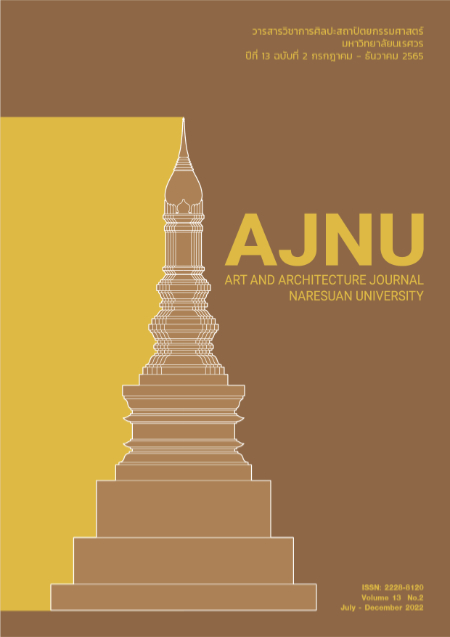Public Participation towards Public Space Development Projects in Low-Income Community: A Case Study of Khlong Toei Community, Bangkok
Main Article Content
Abstract
Increasing green areas or public spaces in urban communities to meet the standards is one of the measures for improving the quality of life of people in Bangkok. However, the development of public spaces in low-income communities in Bangkok, such as Khlong Toei Community, has limitations and unique characteristics that are different from other communities. This is due to the Khlong Toei Community caused by migrants and invasions to build housing for workers for more than 40 years. The purpose of this study is to study and analyze physical characteristics, the economy and society of the area in the Khlong Toei Community and to study the level of participation in the development of public spaces for low-income communities by surveying the real situation, collect relevant document information, and interviewing residents of the community using the interview form. From the results of the study, it can be concluded that public space projects which are suitable for low-income communities should have a starting point from the community's own needs. The residents in the community will know the causes of problems and needs causing the project to be able to solve the problems of the community. However, for the project implementation, there should be an organization or an expert group that has experience and expertise in community project development to organize activities that enable people to participate and reflect the needs of the community. Public space projects should consider acquiring and sharing benefits that truly meet the needs of the community. In addition, project budgets should be allocated to cover the maintenance or establishment of community funds to provide a budget for project implementation to sustainably serve people in the community.
Article Details

This work is licensed under a Creative Commons Attribution-NonCommercial-NoDerivatives 4.0 International License.
References
กรมการปกครองกระทรวงมหาดไทย. (2561). รายงานสถิติจำนวนประชากรและบ้านประจำปี พ.ศ.2560. [ออนไลน์]. เข้าถึงได้
จาก http://stat.bora.dopa.go.th [สืบค้นเมื่อ วันที่ 16 พฤศจิกายน 2563]
กองนโยบายและแผนงาน สำนักการวางผังและพัฒนาเมือง กรุงเทพมหานคร. (2561). สถิติข้อมูลชุมชนในเขตกรุงเทพมหานคร
พ.ศ.2561. [ออนไลน์]. http://www.bangkok.go.th/upload/user/00000354/plan/report/07.pdf [สืบค้นเมื่อ วันที่ 16
พฤศจิกายน 2563]
กลุ่มงานประสานการถ่ายโอนภารกิจ กองยุทธศาสตร์ การเงินและการคลัง. (2554). รายงานผลการศึกษาบริบทเพื่อการพัฒนาเชิง
พื้นที่กลุ่มการปฏิบัติงานของสำนักงานเขต : กลุ่มกรุงเทพใต้. สำนักยุทธศาสตร์และประเมินผล.
สำนักงานคณะกรรมการพัฒนาการเศรษฐกิจและสังคมแห่งชาติ. (2564) แผนการแก้ไขปัญหาชุมชนแออัดและพัฒนาคุณภาพชีวิต
ของคนจนในเมืองอย่างยั่งยืน. สถาบันวิจัยเพื่อการพัฒนาประเทศไทย.
ไพรัตน์ เตชะรินทร์. (2560). การมีส่วนร่วมสร้างชุมชนเข้มแข็งขององค์การบริหารส่วนจังหวัดสมุทรสงคราม. [ออนไลน์]. เข้าถึง
ได้จาก https://so03.tci-thaijo.org [สืบค้นเมื่อ วันที่ 16 พฤศจิกายน 2563]
สถาบันพระปกเกล้าและมูลนิธิอาเซีย. (2535). คู่มือ การมีส่วนร่วมของประชาชนในการตัดสินใจของชุมชน. ศูนย์สันติวิธี เพื่อ
พัฒนาประชาธิปไตย สถาบันพระปกเกล้า.
สถาบันพัฒนาองค์กรชุมชน (องค์การมหาชน) กระทรวงการพัฒนาสังคมและความมั่นคงของมนุษย์. (2561). คู่มือการบริหาร
โครงการ “การสนับสนุนการพัฒนาชุมชนท้องถิ่นและขบวน องค์กรชุมชน” ประจำปีงบประมาณ พ.ศ.2561. [ออนไลน์].
เข้าถึงได้จาก https://web.codi.or.th [สืบค้นเมื่อ วันที่ 16 พฤศจิกายน 2563]
สถาบันพัฒนาองค์กรชุมชน (องค์การมหาชน) กระทรวงการพัฒนาสังคมและความมั่นคงของมนุษย์. (2563). คู่มือโครงการพัฒนา
คุณภาพชีวิตของผู้มีรายได้น้อยในชุมชนเมืองและชนบท.[ออนไลน์]. เข้าถึงได้จาก https://web.codi.or.th [สืบค้นเมื่อ
วันที่ 16 พฤศจิกายน 2563]
สถาบันพัฒนาองค์กรชุมชน (องค์การมหาชน) กระทรวงการพัฒนาสังคมและความมั่นคงของมนุษย์. (2563). คู่มือการบริหาร
โครงการการสนับสนุนการพัฒนาชุมชนท้องถิ่นและประจำปีงบประมาณ พ.ศ. 2564. [ออนไลน์]. เข้าถึงได้จาก
https://web.codi.or.th [สืบค้นเมื่อ วันที่ 16 พฤศจิกายน 2563]
สำนักงานเขตคลองเตย. (2557). ข้อมูลประกอบการพิจารณาความเหมาะสมในการกำหนดกิจกรรม เพื่อพัฒนาพื้นที่เขตคลอง.
กรุงเทพมหานคร. สำนักงานเขตคลองเตย. (2557). รายงานผลการจัดเก็บข้อมูลพื้นฐานฉบับปรับปรุง ชุมชนคลองเตย
(แก้ไขล่าสุด 2557). กรุงเทพมหานคร: สำนักพิมพ์คำผาง.
สำนักงานนโยบายและแผนทรัพยากรธรรมชาติและสิ่งแวดล้อม กระทรวงทรัพยากรธรรมชาติและสิ่งแวดล้อม (2560). แนวทางการ
จัดการพื้นที่สีเขียว สำหรับชุมชนเมืองในประเทศไทย. [ออนไลน์]. เข้าถึงได้จากhttp://www.onep.go.th [สืบค้นเมื่อ วันที่
พฤศจิกายน 2563]
สำนักยุทธศาสตร์และประเมินผล กรุงเทพมหานคร ศาลาว่าการกรุงเทพมหานคร. (2555). แผนพัฒนากรุงเทพมหานคร ระยะ 20
ปี (พ.ศ.2556 - 2575). [ออนไลน์]. เข้าถึงได้ http://www.bangkok.go.th/upload/user/00000073/web/ita/O4.pdf
[สืบค้นเมื่อ วันที่ 16 พฤศจิกายน 2563]
สำนักสิ่งแวดล้อม กรุงเทพมหานคร. (2560). พื้นที่สีเขียวเพื่อสภาพแวดล้อมที่ดีของ กทม. แสดงจำนวนพื้นที่สวนสาธารณะ
ปัจจุบันของกรุงเทพมหานคร 7 ประเภท. [ออนไลน์]. เข้าถึงได้จาก http://203.155.220.118/green-parks-
admin/reports/chartbygardentype_parks7.php [สืบค้นเมื่อ วันที่ 16 พฤศจิกายน 2563]
Andriof and Waddock, (2002). “Stakeholder Engagement: Theory, Responsibility and Engagement” [ออนไลน์].
เข้าถึงได้จาก https://www.researchgate.net [สืบค้นเมื่อ วันที่ 16 พฤศจิกายน 2563]
Creighton, J. L. (1981). “The Public Involvement Manual.” Cambridge: Abt Book.
Iwashita, H. (1988). “Pocket park” Tokyo: Process Architecture Pub. Co.
Mehaffy, e al. (2019). “Public Space in the New Urban Agenda: Research into Implementation” [ออนไลน์].
เข้าถึงได้จาก https://www.researchgate.net [สืบค้นเมื่อ วันที่ 16 พฤศจิกายน 2563]
Manetti, D. M. (2011). “The Quality of Stakeholder Engagement in Sustainability Reporting: Empirical
Evidence and Critical Points” [ออนไลน์]. เข้าถึงได้จาก https://www.researchgate.net [สืบค้นเมื่อ วันที่ 16
พฤศจิกายน 2563]
WHO. (1992). “Promoting Sustainable human settlement development.” [ออนไลน์]. เข้าถึงได้จาก www.who.int
[สืบค้นเมื่อ วันที่ 16 พฤศจิกายน 2563]
Zucker, P. (1959). “Town and Square from the Agora to the Village Green” New York: Columbia University
Press.


